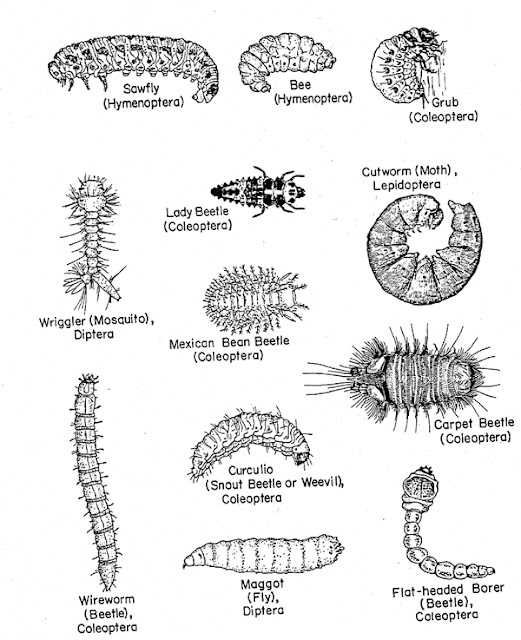Insects are one of
the organisms that undergo metamorphosis either incomplete or complete. In incomplete metamorphosis insects change from the eggs to larvae to adult. In all insects
undergo three major changes in incomplete metamorphosis. Complete metamorphosis
is the other way round, in this insects undergo four major changes. They
develop from egg to larvae to pupa to adult (imago). In the larvae and pupa stage, there are some
types depending on the nature and the physiology of the organism. Here are some
basic types of larva and pupa.
TYPES OF LARVAE
Larvae is
the feeding stage in which it undergoes complete transformations of body shape
feeding habits and others. It accumulates enough food for the pupal stage as
well as the adult stage till adult is able to fend for itself.
1.
ERUCIFORM: Caterpillars
with a cylindrical body, short thoracic legs and abdominal pro-legs. They possess
hypognathous mouth-parts. They are usually found in lepidoptera.
2.
CAMPODEIFORM: Elongated flattened body with
prognathous mouth-parts, well developed thoracic legs adapted for running. They also
possess cercus or cerci. They are usually found in coleoptera and neuroptera.
3.
ELATERIFORM: Wireworm-like in nature, larvae
are smooth, cylindrical with short legs and though skin.
4.
SCARABEIFORM: Grub-like in nature, curved ,
well developed head with thoracic legs but no abdominal legs
5.
VERMIFORM: Maggot-like (worm-like) elongate
with a cylindrical body and no legs.
TYPES OF PUPAE
Pupa is
the resting stage during which period muscles, wings and other characteristic
features are developed. It is the period during which larva is transformed to
adult.
1. OBTECT: This is the type of pupa has an antennae, wing
pads and legs glued to its body. Example butterfly pupa (chrysalis),
lepidoptera.
2. EXARATE: it looks like a pale mummified
adult not covered by cocoon. Appendages are free and undergo complete metamorphosis. Examples include Diptera and Lepidoptera.
3. CO-ARTATE: It looks like an exarate but
the last skin is hardened over it (puparium). They are usually found in some
Diptera.


Can you please tell me what is type of pupa which is shown in the photograph that you have used? This sam pupa is at my home.
ReplyDelete